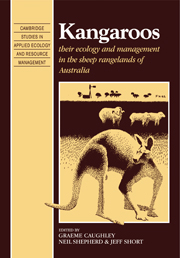Book contents
- Frontmatter
- Contents
- Preface
- Dedication
- THE STUDY AREA IN CONTEXT
- 1 Introduction to the sheep rangelands
- 2 The environment of the Australian sheep rangelands
- 3 The effect of weather on soil moisture and plant growth in the arid zone
- 4 Plant dynamics
- 5 The diet of herbivores in the sheep rangelands
- 6 Factors affecting food intake of rangelands herbivores
- 7 The mobility and habitat utilisation of kangaroos
- 8 Kangaroo dynamics
- 9 Condition and recruitment of kangaroos
- 10 Ecological relationships
- 11 Options for management of kangaroos
- Appendices to Chapter 8
- REFERENCES
- Author index
- Subject index
1 - Introduction to the sheep rangelands
Published online by Cambridge University Press: 05 November 2011
- Frontmatter
- Contents
- Preface
- Dedication
- THE STUDY AREA IN CONTEXT
- 1 Introduction to the sheep rangelands
- 2 The environment of the Australian sheep rangelands
- 3 The effect of weather on soil moisture and plant growth in the arid zone
- 4 Plant dynamics
- 5 The diet of herbivores in the sheep rangelands
- 6 Factors affecting food intake of rangelands herbivores
- 7 The mobility and habitat utilisation of kangaroos
- 8 Kangaroo dynamics
- 9 Condition and recruitment of kangaroos
- 10 Ecological relationships
- 11 Options for management of kangaroos
- Appendices to Chapter 8
- REFERENCES
- Author index
- Subject index
Summary
Context and questions
In this book we examine the sheep rangelands of Australia, not as they were but as they are today. We focus particularly on the chenopod shrublands, a plant association that covers 5–10% of the arid and semi-arid areas of Australia (Goodall, 1979) and which occurs mainly in the winter rainfall zone (150–500 mm per year) of southern Australia (Oxley, 1979).
Our main region of study is the Menindee District (Fig. 1.1) of western New South Wales. Within this we studied two areas, the first being Kinchega National Park (440 km2). Here we examined the structure and dynamics of a grazing system comprising a vegetation dominated by perennial chenopods and annual grasses and forbs, grazed and browsed by a suite of herbivores dominated by the red kangaroo and the western grey kangaroo. The second study area is Tandou sheep station (810 km2, of which we measured the vegetation on 200 km2 and the kangaroos on about 400 km2) which abuts Kinchega to the south. There we studied much the same system as on Kinchega, but with sheep added to it.
Rainfall averages 236 mm per year but varies prodigiously between years (see Chapters 2 and 3). The weather is the driving variable of this arid-zone system, largely determining the biomass of the pasture layer month by month (see Chapter 4) and through its influence on that layer determining what the herbivores eat at any given time (see Chapter 5), how much they eat (see Chapter 6), and how far they have to move to get it (see Chapter 7).
- Type
- Chapter
- Information
- KangaroosTheir Ecology and Management in the Sheep Rangelands of Australia, pp. 1 - 13Publisher: Cambridge University PressPrint publication year: 1987
- 7
- Cited by



